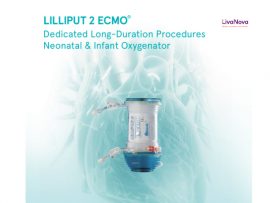Abstract Introduction Two techniques are commonly used for the femoral artery puncture closure during decannulation in venoarterial extracorporeal membrane oxygenation (V-A ECMO): the conventional post-closure technique and the small-sheath technique, also..
Read MoreAbstract Extracorporeal Membrane Oxygenation (ECMO) is a life-saving cardiopulmonary support for patients with acute heart failure. However, the process of weaning from veno-arterial (V-A) ECMO remains complex and risky. We..
Read MoreAbstract Weaning from veno-arterial extracorporeal membrane oxygenation (V-A ECMO) and determining the optimal timing for liberation from mechanical circulatory support (MCS) remain critical yet complex. Although multiple weaning protocols exist,..
Read MoreAbstract Background Venoarterial extracorporeal membrane oxygenation (V-A ECMO) use to support patients in cardiac failure is increasing. Despite this increased use, predicting successful weaning from ECMO can be challenging, no..
Read MoreAbstract Background Clinical evidence regarding predictors of successful weaning from mechanical circulatory support (MCS) is lacking. This study aimed to create a simple risk score to predict successful weaning from..
Read MoreAbstract Background: We evaluated the impact of noninvasive respiratory support (NRS) and invasive mechanical ventilation duration before venovenous extracorporeal membrane oxygenation (VV-ECMO) on weaning from venovenous ECMO and survival. Methods: In..
Read MoreAbstract Aims Knowing the upper time limit for successful weaning from temporary mechanical circulatory support in cardiogenic shock will help with decision‐making regarding advanced heart failure (HF) therapy or considering..
Read MoreAbstract Difficult weaning from invasive mechanical ventilation is associated with adverse clinical outcome and increased use of limited health care resources. Difficult weaning, characterized by failure of multiple spontaneous breathing..
Read MoreAbstract With advancements in (ECLS) technologies, venoarterial (VA-ECMO) has emerged as a crucial cardiopulmonary support mechanism. This review explores the significance of VA-ECMO system configuration, strategies, and timing of initiation. Through an analysis..
Read MoreAbstract Introduction Pump-controlled retrograde trial off (PCRTO) is described as an effective weaning strategy for veno-arterial extracorporeal membrane oxygenation (ECMO) in the guidelines. Contrastingly, there is no established weaning strategy..
Read MoreAbstract Venovenous extracorporeal membrane oxygenation (VV ECMO) facilitates the reduction of mechanical ventilation (MV) support in acute respiratory failure. Contrary to increasing evidence regarding its initiation, the optimal timing of..
Read MoreAbstract Background and Aim: To assess the utility of ultrasonic markers like B-line score (LUS), diaphragm thickness (DT), thickening fraction (DTF), and excursion (DE) as predictors of weaning outcomes in..
Read MoreAbstract Objective: Analysis of the prevalence and risk factors for weaning failure from venovenous extracorporeal membrane oxygenation (VV-ECMO) in patients with severe acute respiratory insufficiency. Design: Single-center retrospective observational study. Setting: Sixteen beds medical ICU at the University..
Read MoreAbstract BACKGROUND Post-cardiotomy veno-arterial extracorporeal membrane oxygenation (V-A ECMO) is characterized by discrepancies between weaning and survival-to-discharge rates. This study analyzes the differences between post-cardiotomy V-A ECMO patients who survived,..
Read MoreAbstract Background Safe and timely liberation from veno-venous extracorporeal membrane oxygenation (V-V ECMO) would be expected to reduce the duration of ECMO, the risk of complications, and costs. However, how..
Read MoreAbstract Extracorporeal membrane oxygenation (ECMO) has strikingly progressed over the last 20 years in the management of adult and pediatric severe respiratory and cardiac dysfunctions refractory to conventional management. In this..
Read MoreAbstract Venoarterial extracorporeal membrane oxygenation (V-A ECMO) is increasingly used in cardiogenic shock for rapid stabilization and bridging towards recovery, long-term mechanical circulatory support or transplant. Although technological advances have..
Read MoreAbstract Veno-arterial extracorporeal membrane oxygenation (VA-ECMO) provides a temporary support system for patients with cardiogenic shock refractory to conventional medical therapies. It has been reported that levosimendan may facilitate VA-ECMO..
Read MoreAbstract Background Weaning from venovenous extracorporeal membrane oxygenation (VV-ECMO) is not well studied. VV-ECMO can be discontinued when patients tolerate non-injurious mechanical ventilation (MV) during a sweep gas off trial..
Read MoreAbstract Patients who receive venovenous extracorporeal membrane oxygenation (VV ECMO) support upon failure of invasive mechanical ventilation (IMV) and other adjuncts, including low tidal volume, prone positioning, adjusted positive end-expiratory pressure, and..
Read MoreECMO patient selection, cannulation strategies, weaning and how we manage staffing for ECMO patients.
Read MoreECMO: Measurement Of Adequacy, Cannulation, North/South Complication, Anticoagulation And Weaning, And What Patients Can Be Woken Up And Extubated On VV ECMO?
Read MoreAbstract Objective Weaning from venoarterial extracorporeal membrane oxygenation (VA ECMO) usually is performed without clear guidelines; yet, patients still die after removal of extracorporeal circulation because of inadequate heart or..
Read MoreAbstract OBJECTIVES Left-sided unloading during extracorporeal membrane oxygenation (ECMO) therapy is crucial to prevent pulmonary oedema and facilitate ventricular recovery. We present the case of a 55-year-old man under ECMO..
Read MoreAbstract Weaning failure and mortality rates in veno-arterial extracorporeal membrane oxygenation (VA-ECMO) supported patients are significant. Small studies suggest the possible usefulness of levosimendan in this environment, especially in postcardiotomy..
Read More














